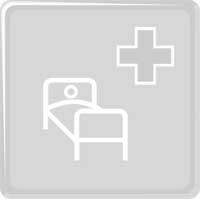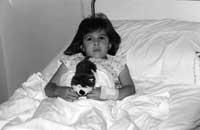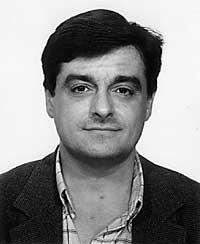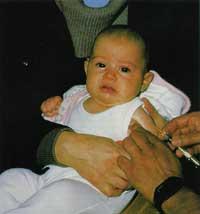New vaccination campaign in the CAPV
1996/05/01 Eusko Jaurlaritzako Osasun saila Iturria: Elhuyar aldizkaria
The control of these diseases is one of the priority activities for Public Health and one of the epidemiology services. Taking all this into account, it is necessary to define direct lines of action to prevent meningitis, always based on the principles of epidemic control: taking cases such as epidemic manifestations, analysis and prophylaxis of contacts, providing adequate vaccination systems, etc.

Most cases of meningitis originate from Neissaria bacteria, better known as meningitidis or meningococcus. Unfortunately, there is no vaccine against this microorganism, so measures taken to avoid diagnosis, adequate treatment and contact with patients are the most effective means to combat the disease. However, it is not the only bacteria that produce meningitis. Haemophilus influenzae also causes disease, but its incidence is lower. To do this, there is an effective vaccine that was started in Spain about a year ago.
The control of meningococcal meningitis is possible through different disease warning systems, something that has been done regularly in the E.A.E. On the contrary, until 1994 there is no reliable data available in the Autonomous Community of the Basque Country regarding what was created by Haemophilus influenzae. From that year on, the Basque Government's Department of Health began collecting detailed information on the disease to make a decision on vaccination. The suggestions of the Euskadi Vaccination Advisory Council were taken into account.
In January 1994, the microorganism control system with large coverage in the Autonomous Community of the Basque Country assumed the case study of Haemophilus influenzae. A retrospective survey was conducted to locate the cases between 1988 and 1994. In addition, the cases of 1993 and 1994 were analyzed by reviewing hospital discharges.
Meningitis and diseases that could have to do with Haemophilus influenzae were listed: meningitis itself, pneumonia, epiglotitis, arthritis, etc. The aim of the study was for children under 5 years of age. After a thorough analysis of all these data, the incidence of meningitis and Haemophilus influenzae among children in this age group was known (see table 1).
This data shows that in the Autonomous Community of the Basque Country the incidence of cases of pollution meningitis by Haemophilus influenzae is higher than 15 in 100,000 children under five years of age, a figure that is increased if all invasive diseases are taken into account. If these levels of incidence are analyzed epidemiologically, they indicate the need to launch special vaccination campaigns. Before reaching this conclusion, studies conducted in other municipalities were taken into account (see table 2).
E.A.E.MeningInvasive diseases1988-92 1993 199413 19 1722 29 23Vaccination tips and criteria
The Department of Health of the Basque Government, in view of the recommendations of the Advisory Council on Vaccination, the data derived from epidemiological studies, the existence of vaccines against the disease and the various operational aspects, decided to offer the possibility of incorporating all children born from 1 January 1996.
The vaccination method was launched on 1 March. The recommended sequence for the introduction of the preparation, meanwhile, provides 4 doses, the first at 2 months and the rest at 4, 6 and 18 months, coinciding with the stages in which DTP (diphtheria-tetanus tosterin) and antipolar preparations are currently integrated.
As mentioned above, all children born from January of this year may be vaccinated. And according to the estimated data, this year around 15,500 children will be born in the ACBC.
Today, E.A.E. is the first autonomous community to offer the vaccine, since it is not expected anywhere else in the schedule of vaccination for children. The first year of implementation of the system will invest 65 million pesetas in the purchase of the vaccine.
Characteristics of the Haemophilus influenzae vaccine
The vaccines currently available in the Spanish state market have their origin in the mixture of two different models. It is, on the one hand, HibTITER R, produced in the laboratory called Lederle, mixed with the protein PRP-CRM and, on the other, mixed with the substance Act HiB R, PRT-T of the laboratory Pasteur-Merieux.
Both vaccines have demonstrated their ability to fight the disease in children under 18 months. They also store information about protection mechanisms. Vaccination is recommended for more than 2 months.
Vaccination is intramuscular and should always be placed on the thigh where the DPT vaccine has not been placed. As for side effects, it should be noted that the detected symptoms are provisional and do not produce adverse effects in the short term, inflammation, itching or erythema have been detected, but not important.
To carry out the vaccination program of the Autonomous Community of the Basque Country, the Department of Health of the Basque Government selected the HibTITER R vaccine, which will be used hereinafter.

Gai honi buruzko eduki gehiago
Elhuyarrek garatutako teknologia






